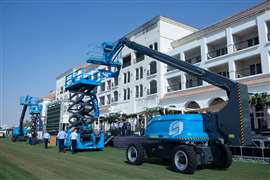Flexible friends
06 March 2017

Telescopic crawler cranes are becoming an increasingly common sight. It’s their versatility and flexibility that are making them such an attractive proposition. With telescopic booms that allow access to places barred to their bigger crane brethren, the ability to move with a load on the hook, fast setup times, a high degree of mobility, and a road-friendly nature, this adaptability is making them a prized piece of machinery.
This attribute is emphasised by Florian Attenhauser, spokesperson for German crane manufacturer Sennebogen. “Telescopic cranes offer excellent flexibility on site thanks to the fact they can travel and telescope while under load,” he says. He specifically identifies four key benefits telecrawlers bring: ease of transportation; short rigging times; increased ease of access; and time-savings thanks to the efficiency of an extendable and retractable boom. “Thanks to their small dimensions, most of our telescopic crawler cranes can be transported using a normal flatbed trailer,” Attenhauser adds.

Sennebogen says its telecrawlers are ready to work on slopes of up to 4 degrees, eliminating the need for time-consuming set-up procedures
“Short rigging times are the second benefit,” he continues. “Telecrawlers can simply be unloaded and they are ready to go. They don’t need flat, even ground or stabilising before the crane can be erected. Thanks to the robust crawler tracks, the cranes can stand safely on their own and work up to an inclination of four degrees. This makes them easy to move around a job site. Long assembly times due to boom erection, the use of auxiliary cranes, and extra ground stabilisation can all be negated.
“Thanks to their small dimensions, telescopic cranes can also be set up with little space requirements. Machines can even drive into buildings, underneath bridges, and in tunnels thanks to their flexible boom system, which can be varied quickly and easily.”
Further flexibility is possible thanks to the various attachments available, enabling the crane to be used for a wide range of applications. Fly booms and boom extension are also available and, if desired, Sennebogen’s own line of telecrawlers can carry a working platform.
Multiple applications

The new Grove GHC30, launched by Manitowoc at the ConExpo show, is the smallest in the company’s GHC line. It claims that its compact dimensions offer exceptional manoeuvrability and efficiency for a wide range of applications
This flexibility means telecrawlers can be used for a host of applications in a range of environments around the world. For example, a Liebherr LTR 1220 is playing a key role in a cutting-edge energy generation and storage facility construction project to the north-east of Baden-Württemberg in Germany. This project is being executed by international construction company Max Bögl Group and involves the construction of a pump accumulator power plant with four wind turbines, each planted in the centre of a circular water basin. Once complete the water basin will have a diameter of 63 metres and a height of around 15 metres.
Using some lateral thinking, the Max Bögl Group realised that the flexibility of Liebherr’s LTR 1220 telecrawler made it particularly suitable for this job. The LTR 1220 has a telescopic boom with a reach of up to 60 metres, a maximum radius, with extensions, of 88 metres, a capacity of 220 tonnes, and a maximum hoist height of 101 m. This, combined with the crane’s small footprint, meant that Max Bögl positioned it in the centre of the circular foundation from where it only needs to move a few metres to reach every point of the water basin. In addition, the LTR 1220 can move with 12-tonne reinforced concrete components attached to it, thus streamlining efficiency so that construction work can progress more quickly.
A key challenge to this approach, however, is that, once built, the LTR 1220 will be effectively trapped in the basin. Max Bögl Group’s solution is to use another Liebherr mobile crane to lift the telecrawler out of the basin, after its tracks have been removed.

The popularity of this flexibility that telecrawlers bring has not gone unnoticed by crane manufacturers. For example, crane manufacturer Manitowoc says that in response to customer feedback it has just launched its Grove GHC30 at the recent ConExpo trade show in Las Vegas. The new 30 ton-capacity model is the smallest in the GHC line and Manitowoc says its compact dimensions offer exceptional manoeuvrability and efficiency for a wide range of applications.
The new model will, as with previous models in the series, be offered exclusively in North and Latin America as part of a long-term strategic partnership between Manitowoc and Sennebogen.
According to John Bair, Manitowoc product manager for the GHC range, “Customers indicated that a crane with a smaller footprint would help them increase manoeuvrability and efficiency on many job sites.”
The GHC30 offers the ability to pick-and-carry at 100 percent of its load chart on inclinations up to four degrees, and it can swing loads 360 degrees. It has a compact footprint of 10.6 x 3 x 3 metres, and a tail swing radius of 3.3 metres. This means that it can work on job sites with reduced access and in tighter working quarters that require precise movement.
Grove’s GHC30 has a three-section 25.2 metre telescoping boom and operators can handle a wide range of lifts at various radii without setting up on outriggers in the way traditional hydraulic boom cranes have to, thus saving time.

This Grove GHC75 was used as a pile driver in tough conditions, driving piles into the wet, uneven soil of a creek bed with only a 30-foot (10 metre) radius for contractors to work in
Efficient working
For further efficiency, the crane can be transported in one load on the back of a truck and requires minimal setup. Attachments available include an offsettable, swing away boom extension in lengths from 6.5 to 13 metres. With this fitted the maximum tip height is 40.2 metres. In addition, a two-person work platform, a boom-mounted hydraulic auger attachment, and a pole claw are also available. According to Manitowoc, this will be particularly useful for companies working on power line projects, as they will be able to drill holes with the auger and then use the claw to lift and position the poles with only one crane. This helps contractors keep overall project costs to a minimum as they no longer need multiple pieces of equipment.
The company also says that the GHC30’s crawler tracks mean it can easily navigate tough conditions, for example, swampy or mountainous terrain. The track side frames can be hydraulically extended and retracted to offer three track spans with lifting capabilities at each span. This, Manitowoc says, offers added versatility enabling users to find the best combination of crane width and lifting capacity.
This ability to tackle tough terrain is an important plus point for telecrawlers and one of the reasons why Manitowoc’s more established models, for example, the Grove GHC75, have proved so popular. This is illustrated by a recent park restoration project in Rogers, Arkansas, USA. The work was carried out by site development and paving specialist Arco Excavation & Paving and involved building an elevated retaining wall. A Grove GHC75 was used, this time as a pile driver. According to Manitowoc, conditions were terrible, as the piles had to be driven into the wet, uneven soil of a creek bed with only a 10 m radius for contractors to work in. Mike Snook, who worked for Arco as the foreman on the project, had never worked with a telescoping crawler crane before. After discovering the GHC75, though, he says he was confident that he could handle the pile-driving without using a much larger crane, saving time and money on the job. “I’ve got 20 years of excavation experience,” he says, “but driving piles with a telescoping crawler crane was relatively new to me. I went to the rental yard thinking I would be coming back with a larger lattice boom crane but the Grove GHC75 was better-suited for this type of project. It had the crawler tracks to manoeuvre with and a compact footprint that could fit on this job site.”
Snook reports that the GHC75’s rated capacity limiter with graphical display was easy to use, providing all the necessary operating parameters and advanced, real-time diagnostics. When combined with the crane’s load chart, Snook says he found that he could quickly set up his lifts with even more confidence than usual. “Even after reviewing the load chart to prepare for each lift, this crane had more to teach me as I went along,” he explains. “It told me what I could and couldn’t pick up in real-time and assisted me in making adjustments before each lift. I was trying to avoid lifting at 70 percent of my load, and the in-cab display made it easier for me to stay between 40 and 60 percent.”
Snook claims the crane’s manoeuvrability played an equally important role as its controls. The three-position, hydraulically extendable undercarriage - which adjusts the width of the crawler’s tracks by moving them inward or outward from the crane’s centre - provided maximum flexibility on the job, enabling him to perform heavy lifts in a small, uneven space. In addition, the crane’s pick-and-carry capabilities enabled the telecrawler to quickly move around on the job site since no outriggers were needed. “We were working in very tight quarters on that creek bed,” Snook continues. “We also had to contend with cars driving past all day long so there was no room to set up the outriggers you find on a more traditional hydraulic crane. With the GHC75 I was able to drive right into place, spread the tracks out all the way and perform the lift.”
Another US riverside project in which a site’s tight clearances led to the use of a telecrawler is the construction of the new Grand Avenue Bridge in Glenwood Springs, Colorado, USA. Once completed the new bridge will cross the Colorado River, the Union Pacific Railroad, and four lanes of Interstate 70.
Washington-based Malcolm Drilling was responsible for drilling caissons for the new five-span welded steel box girder bridge, which will replace the previous bridge. This involved drilling a shaft, lowering a rebar cage into the shaft, and then filling it with concrete each day. In total, 26 caissons were drilled and filled to hold up pier caps for the new bridge. Concrete piers for the eventual bridge superstructure will eventually rest above the 16.4-metre-deep caissons.
Malcolm Drilling says it spent considerable time and effort studying various crane options before it decided to use a telecrawler. It opted for the TCC-1100 from US crane manufacturer Link-Belt, to lift and manoeuvre a 56,000 pound (25,401.1 kg) oscillator underneath the 36 foot (11 m) clearance of the existing bridge.
Captivating capabilities
According to Link-Belt, the TCC-1100’s boom tip, load capacity and height specifications were integral to the company’s decision to use this crane. “We fell in love with the capabilities of the TCC-1100 and what it could do for this type of work,” says Todd Williams, Malcolm Drilling superintendent. “It has the mobility to go where you need it to and is able to telescope the boom in and out. For what we do, it’s perfect.”
High praise indeed. Looking to the future, however, Link-Belt is not one to rest on its laurels. It launched the 250 US ton (230 tonne) capacity TCC-2500 this month. The company describes it as the highest capacity telecrawler available in the market. Yet, even on this scale, flexibility remains a key selling point. “The TCC-2500’s job site flexibility is a huge benefit,” Scott Knight, Link-Belt product manager, lattice and telescopic crawler cranes, says. “The TCC-2500 can lift, reach, and travel like a large fixed boom lattice crawler while also having the ability to retract the boom and reduce its overall profile as job site conditions and environment requires. It is well positioned to lead telecrawlers into a whole new arena of jobsite opportunities.”
So there are exciting times ahead in the telecrawler sector as end users’ appetite for these flexible friends continues apace, leading to crane manufacturers evolving more new variants to satisfy the market. And with the machines’ ability to perform multiple roles in demanding environments, they will become an increasingly important weapon in the construction manager’s arsenal.
British antarctic survey selects sennebogen duo

UK-based equipment sales, servicing and rental company, AGD Equipment supplied two Sennebogen 643R telescopic crawler cranes to the British Antarctic Survey (BAS) for use at the South Pole. The high-profile project involves relocating the Halley Research Station so that it isn’t cut-off from the ice shelf by a previously dormant ice chasm that has now opened up.
According to Robert Law, AGD managing director, BAS had seen a Sennebogen crane being utilised by another research station in Antarctica and determined that it would be the perfect solution to help it uncouple and relocate the research station’s modules to a new location 23 km away. Commenting on the project, AGD says, “We are proud to be associated with the relocation of Halley Research Station in the South Pole by way of supplying two brand-new Sennebogen 643R, 40 tonne telescopic crawler cranes to BAS for the project.”






